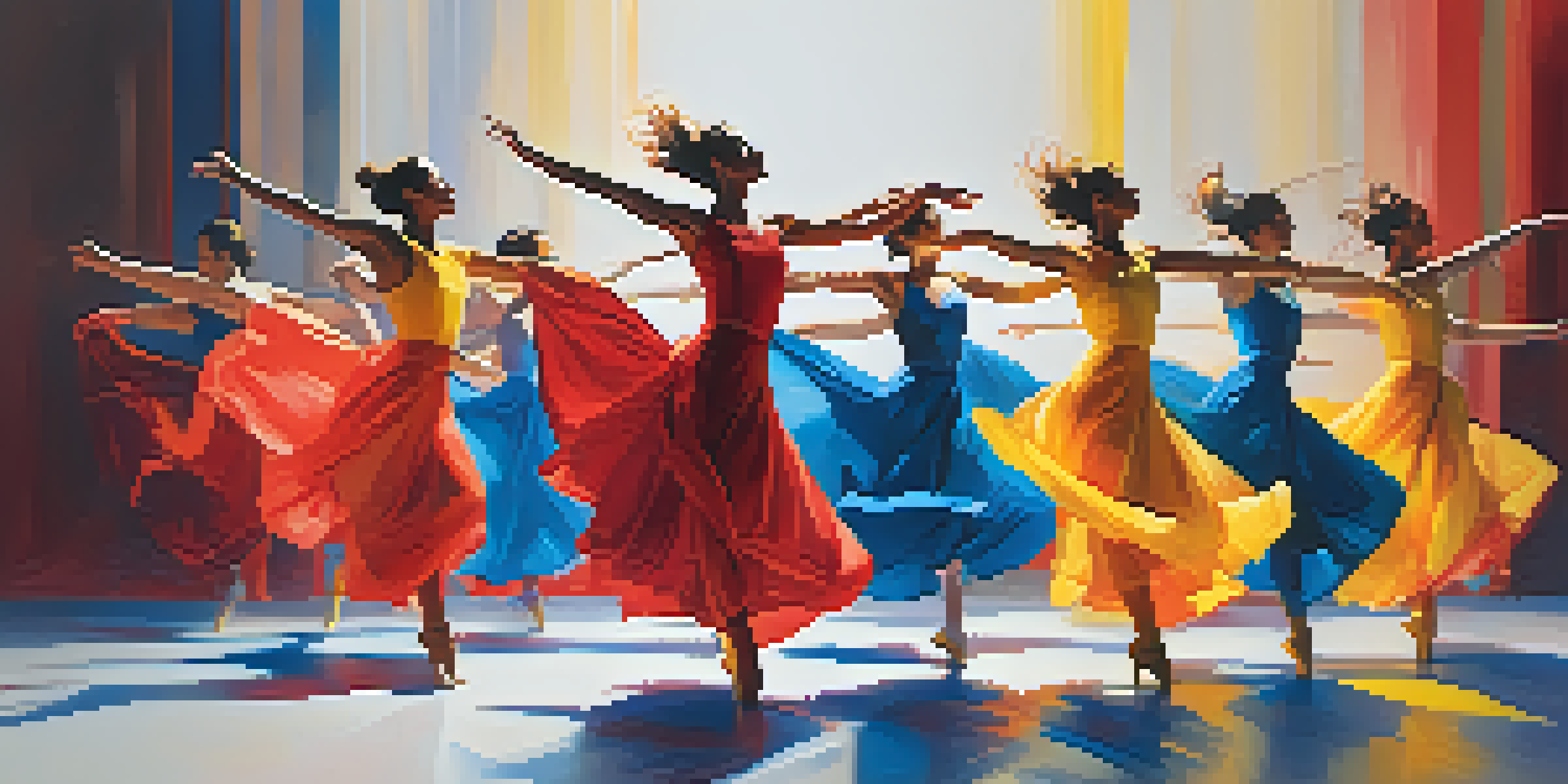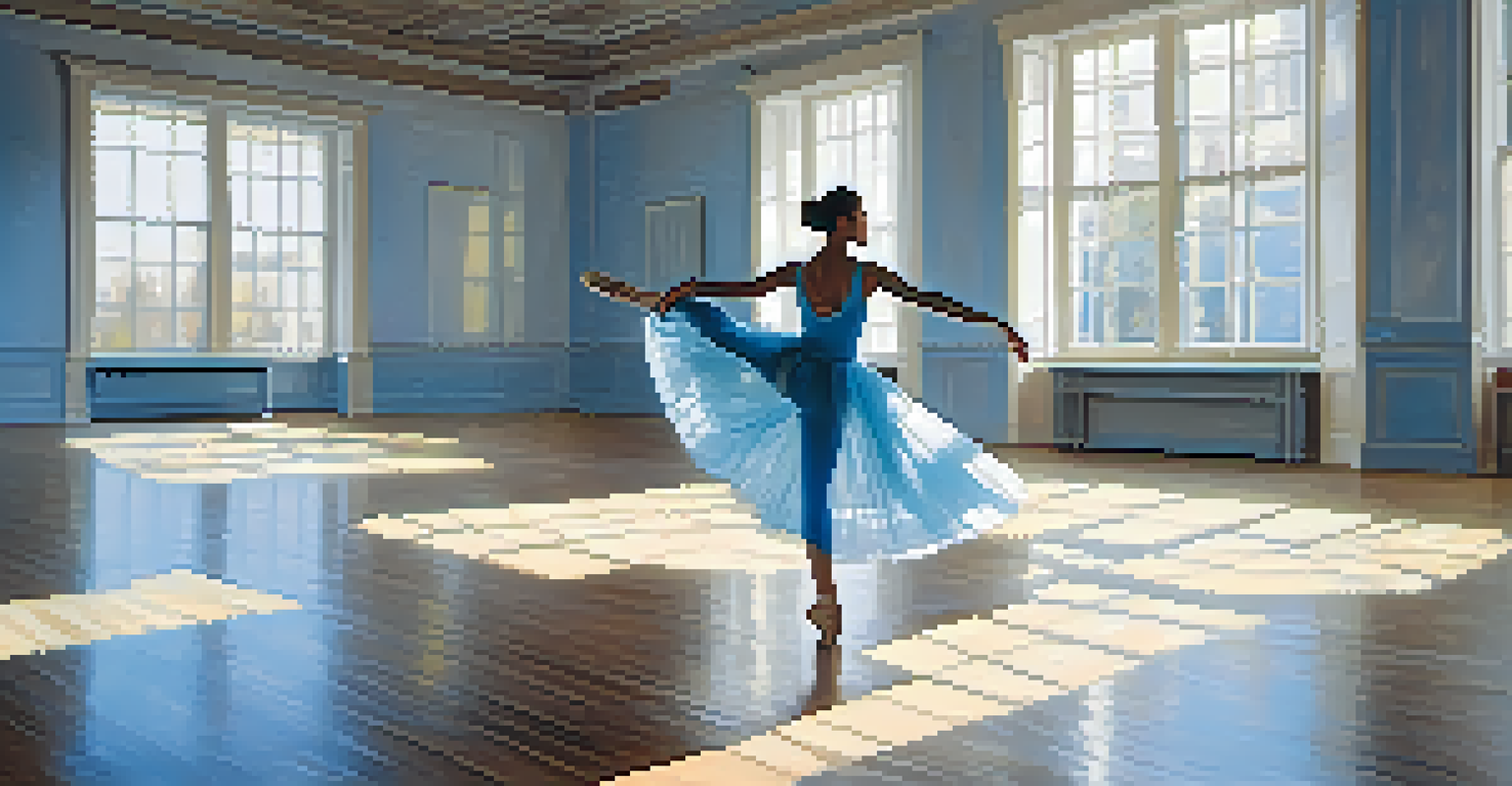How Visual Arts Shape the Perception of Dance

The Interplay Between Dance and Visual Arts
Dance and visual arts share a unique symbiotic relationship, often enhancing each other's impact. When dancers perform, their movements can evoke emotions that resonate with viewers, much like a captivating painting. This connection allows audiences to interpret dance not just as a series of movements but as an expressive art form that tells a story.
Dance is the hidden language of the soul.
For instance, a choreographer might draw inspiration from a renowned painting, allowing its colors and forms to influence the choreography's mood. Likewise, visual artists frequently incorporate dance elements into their work, creating installations that celebrate movement. This intersection encourages a deeper appreciation for both forms of art, allowing each to inform and enrich the other.
Ultimately, the interaction between dance and visual arts invites audiences to engage with both mediums, fostering a richer understanding and appreciation of their respective narratives and expressions.
Visual Imagery Enhancing Dance Performance
Visual imagery plays a crucial role in shaping the audience's perception of dance. From stage design to costume choices, every visual element can deeply influence how a performance is interpreted. For example, a minimalist set may prompt viewers to focus on the dancers' movements, while a vibrant backdrop can enhance the emotional tone of the piece.

Choreographers often work closely with visual artists to create a cohesive aesthetic that amplifies the dance experience. This collaboration ensures that the visual components serve as a complementary force rather than a distraction. Together, they craft an environment where the audience can immerse themselves fully in the performance.
Dance and Visual Arts Enrich Each Other
The collaboration between dance and visual arts creates a multi-layered experience that enhances emotional and intellectual engagement.
As a result, visual imagery not only enhances the beauty of a dance performance but also shapes the emotional and intellectual responses of the audience. This interplay between dance and visual arts creates a multi-layered experience that is both captivating and thought-provoking.
The Role of Color in Dance Interpretation
Color is a powerful tool in the realm of visual arts that can significantly influence how dance is perceived. Different colors evoke distinct emotions; for instance, red can suggest passion or intensity, while blue might convey calmness or sadness. When choreographers use specific colors in costumes or lighting, they set the emotional tone for the performance.
Art is the most beautiful of all lies.
Consider a dance piece where dancers are adorned in bright, bold colors. This choice can energize the audience, drawing them into the performance's vivacity. Conversely, muted tones may evoke a sense of introspection, encouraging viewers to reflect on the deeper themes presented through movement.
By strategically employing color, artists can guide the audience’s emotional journey throughout the dance, making it a more immersive experience. This synergy between color and movement not only enhances the overall aesthetic but also deepens the narrative conveyed through dance.
Symbolism in Dance and Visual Arts
Both dance and visual arts often utilize symbolism to convey deeper meanings, allowing audiences to interpret performances on multiple levels. In dance, movements can symbolize emotions, relationships, or cultural narratives, much like how visual art can depict abstract ideas through shapes and forms. This shared use of symbolism creates a rich tapestry of understanding.
For instance, a dance that incorporates gestures symbolizing freedom may resonate with viewers in a way that transcends language. Similarly, visual artworks that depict themes of liberation can parallel the dancers' movements, creating a unified message across both mediums. This layered symbolism invites audiences to engage with the performance more profoundly.
Color Shapes Dance Perception
Strategically using color in costumes and lighting influences the emotional tone of a dance performance, guiding the audience's experience.
Ultimately, the interplay of symbolism in dance and visual arts fosters a dialogue that encourages viewers to explore various interpretations. This complexity enriches the audience's experience, making the art forms more impactful and memorable.
The Influence of Technology on Dance and Visual Arts
In today's digital age, technology has revolutionized the way dance and visual arts interact. Digital projections, interactive displays, and augmented reality can create immersive environments that transform traditional performances into multi-sensory experiences. This innovation allows for new forms of expression that challenge the boundaries of both art forms.
For example, a dance performance might incorporate projected images that respond to the dancers' movements, creating a visual dialogue that evolves in real-time. This technological integration not only captivates the audience but also adds layers of meaning to the choreography. It demonstrates how visual arts can enhance the storytelling aspects of dance.
As technology continues to advance, the possibilities for collaboration between dance and visual arts are expanding. This evolution provides artists with fresh avenues for creativity, inviting audiences to engage with performances in ways that were once unimaginable.
Cultural Context in Dance and Visual Arts
Cultural context plays a significant role in shaping the perception of both dance and visual arts. Each art form reflects the traditions, values, and stories of its originating culture, allowing audiences to glimpse diverse perspectives. When visual arts are paired with dance, they can amplify the cultural narratives that inform both mediums.
For instance, a dance that celebrates a specific cultural heritage may incorporate visual elements that reflect traditional motifs or symbols. This harmonious integration enriches the audience's understanding of the dance's significance and fosters appreciation for the cultural context. It can also facilitate cross-cultural dialogues, inviting viewers to explore and learn from different artistic expressions.
Technology Transforms Artistic Expression
Innovations in technology allow for immersive experiences that redefine the interaction between dance and visual arts, opening new avenues for creativity.
As audiences engage with performances that highlight cultural contexts, they gain insights into the histories and experiences that shape the art forms. This connection not only enhances their appreciation but also promotes a sense of empathy and understanding across cultures.
The Emotional Impact of Visual Representation in Dance
Visual representation in dance can evoke profound emotional responses from audiences. The combination of movement, color, and imagery creates a sensory experience that transcends words, allowing viewers to connect with the performance on a visceral level. This emotional impact is often heightened when visual arts complement the dance.
For example, a dance performance accompanied by evocative imagery can amplify feelings of joy, sorrow, or nostalgia. The visual elements work in tandem with the dancers' movements, deepening the audience's emotional engagement. This synergy transforms a simple performance into a moving experience that resonates long after the final bow.

Ultimately, the emotional power of visual representation in dance underscores the importance of collaboration between the two art forms. It reminds us that art, in all its forms, has the ability to touch our hearts and minds, creating lasting impressions that inspire and provoke thought.